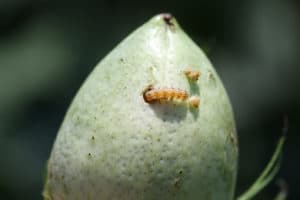
Although current moth activity remains relatively low, I’m expecting a peak of moth activity sometime beginning around August 5th through 10th. Bollworm (a.k.a., corn earworm) poses a significant threat to cotton and soybean, and particularly late planted soybean that are still flowering when the flight arrives. Below are some thoughts on managing for this troubling pest.
Cotton: Our primary concern for economically damaging infestations will be in the two-gene Bt cottons (and of course any non-Bt cotton). For Tennessee, this means almost exclusively Bollgard II, and we know treatment for bollworm is sometimes necessary on Bollgard II varieties. An article from last year discusses treatment options (linked below), but the diamide insecticides such as Prevathon and Besiege are the go to treatments. https://news.utcrops.com/2019/07/thinking-about-bollworm-management-in-cotton/
I would not expect for treatment to be needed on WideStrike 3, Bollgard III, or TwinLink Plus technologies except under unusual circumstances. Having said that, you most definitely should scout these technologies for bollworm infestations. For one thing, mistakes are made, and I’ve been in fields that were supposedly one variety and turned out to be another. However, I would scout the 3-gene technologies differently, paying more attention almost exclusively to square and boll injury to make treatment decisions. Look specifically at one-third to one-half grown squares and small to medium sized bolls. Thresholds based on injury are available at https://guide.utcrops.com/cotton/cotton-insect-guide/bollworm-and-tobacco-budworm/, but an overview of treatment thresholds for bollworm in cotton is below.
Treatment Bt cotton when… four or more surviving larvae (> 1/4 inch or longer) per 100 plants … or … a combination of square and boll sampling shows 6 percent or more injury (or anytime 3% or more boll injury is observed) … and … applications to Bollgard II should be considered when high numbers of eggs are present (> 20% or more of plants with eggs).

Soybean: The treatment threshold in soybean is based on the number of larvae found in sweep net samples, crop value, and control costs, including the cost of (see table below). Given the current situation, the treatment threshold will be in the neighborhood of 7-10 larvae per 25 sweeps. Keep in mind that corn earworm moths are most attracted to late maturing fields, and the worst infestations often occur in the Hatchie or Mississippi River bottoms.
The good news is there are considerably more, good treatment options in soybean than in cotton, in part because extended residual control is generally not needed. It’s generally one spray and done in soybean! Also, corn earworms are easier to control in soybean than cotton. We sometimes can still get away with just a pyrethroid insecticide, although I wouldn’t suggest trying that except when populations are just at or slightly above threshold and you are prepared to make a follow-up application if things go wrong. Products like Besiege, Blackhawk, Intrepid Edge, and Prevathon should all provide good control.
For high risk fields, the use of NPV virus such as Heligen is also an option, but you should start applications earlier. Reduce the threshold to 3-5 larvae per 25 sweeps and make applications when primarily small larvae are present. Don’t use this product in blow-out situations when worms of all sizes are present and populations are well over threshold. A complete list of treatment options is available at https://guide.utcrops.com/soybean/soybean-insect-guide/corn-earworm/.


